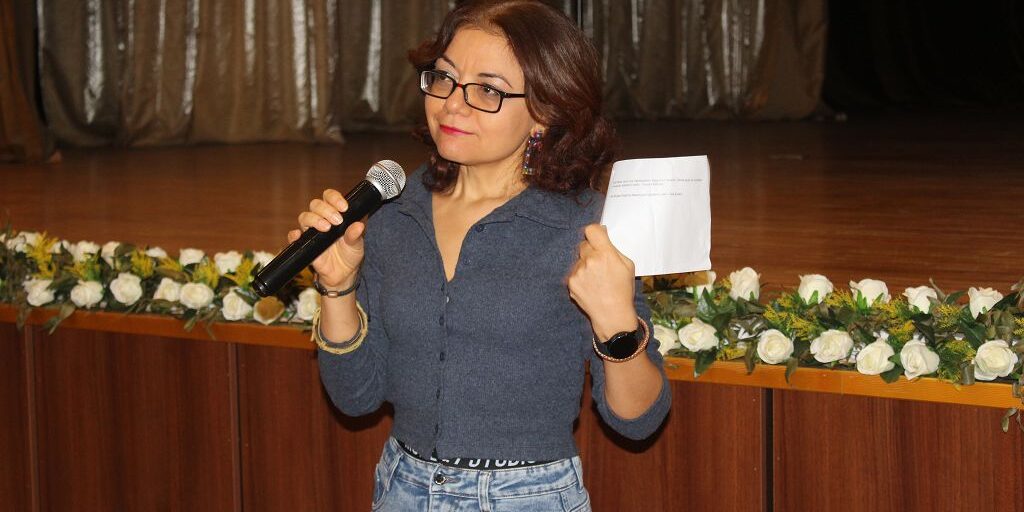You’ve probably seen announcements like Shirvan Cinema Days, Mughan Cinema Days, and Aran Cinema Days on the Azerbaijan Union of Filmmakers (AUF) social media pages. For nearly two years, AUF has been organizing screenings of local feature and short films in regions that haven’t been shown on TV or in shopping malls` cinemas. People in cities and districts far from the capital—Lankaran, Bilasuvar, Imishli, Beylagan, Hajigabul, Saatli, Sabirabad, Shirvan, and others—have been able to watch around 10 new films, many of which even Baku residents could only see at special events. Since most screening venues lack the technical capabilities for high-quality screenings, AUF employees Ulviyya and Ilgar adapt the film formats to suit the available equipment. Executive manager Intigam Hajili carefully checks each film to prevent any technical issues during the screenings and works to overcome bureaucratic hurdles. When possible, filmmakers or film critics attend these screenings to interact with the audience and answer questions.
I know, it might seem a bit pompous, a typical Soviet-era introduction. But I can’t help it. I’ve been involved in this project several times, and each experience has left me with a mix of emotions. A bit of joy, a bit of hope, but mostly regret and sadness. I want to share these feelings with you, but with your permission, I’ll start a bit further back, in the Soviet era. After all, these events are deeply rooted in our past.
As older generations know and younger generations have heard, the Soviet Union placed a strong emphasis on film distribution. In the 1960s, the Soviet Union boasted the highest cinema attendance in Europe. The late Russian film critic and culturologist Daniel Dondurey, who led the “Iskusstvo kino” magazine for over a decade, argued in his article “Kinoprokat: a pearl of the entertainment industry,” that Soviet cinema was financially self-sufficient. It didn’t require subsidies; in fact, it generated significant revenue.
When regions faced cash shortages, a few copies of popular films like “The Diamond Arm,” “Zorro,” or “Yesenia” from the regional or city film distribution departments were enough to solve the problem. When Volgograd was unable to pay the salaries of teachers and doctors, Moscow sent 10-15 copies of the film “Yesenia” as an aid. The film’s screenings in the region helped eliminate the deficit in the local current accounts.
By the mid-1980s, the Soviet Union had built 5,000 cinemas nationwide and installed 70,000 cinema projectors in schools, universities, rural clubs, and cultural centres. Most people, especially young people, went to the cinema every week, mainly because there were limited entertainment options.
One of the reasons that inspired people like Rasim Ojagov and Rasim Balayev, whose films we still enjoy watching today, to pursue a career in cinema was the films they saw in provincial culture clubs and the film crews that came to shoot in their local areas. Similarly, Fehruz Shamiyev, the president and founder of the Baku International Film Festival, a producer, director, and my university classmate, was also drawn to the art of cinema after watching Fellini’s “Amarcord” in a village club.
Unfortunately, this valuable tradition disappeared with the collapse of the Soviet Union and the subsequent war and political chaos in the country. The indifference also played a role in its decline. Today, few of the cultural clubs that once existed in almost every village remain, and the projectors in cultural centres are so outdated that they are unusable for film screenings. In Hajigabul, the cinema projector was so old that it screened the black-and-white film “Sugra and Her Sons” (dir. Ilgar Najaf) as a completely black screen. In Saatli, the projector was positioned in the corner of the wall, projecting films onto the screen in the form of a thin, elongated rectangle. But more importantly, the habit of sitting in a dark hall to watch a film has vanished. It has been replaced by the habit of watching TV series with commercial breaks every ten minutes and scrolling TikTok videos. Most people no longer have the patience to sit in a dark hall for an extended time. If there is one remnant of the past, it is the unofficial administrative orders to pack the halls at such events.
While it’s disheartening to witness such a decline, there have been some truly heartwarming moments. For instance, some audience members who were told by their supervisors to attend the film screenings and initially planned to leave early stayed until the end, watching all the films and participating in the discussions. In each district we visited, several people approached us after the screenings to share their thoughts, express interest in new films, and discuss their favourites. This was particularly evident among young people and schoolchildren. In both Saatli and Sabirabad, schoolchildren who were brought to the screenings by their teachers and were ready to leave after the lights went out for several reasons such as “my mum awaits me”, “the bus is leaving”. But they chose to stay and watch all the films—one feature-length and four short films—and joined in the discussions.
At a recent Cinema Days event held in the Mil-Mughan region, two films proved particularly popular: “Oh, God, I’m here!” (directed by Gulu Askerov) and “The Monologue of a Lonely Man” (directed by Emin Efendiyev). In general, when observing audience reactions to films, it’s clear that viewers prefer a classic narrative style. They find it more challenging to engage with silent films, and they are not yet accustomed to reading subtitles. However, they still manage to connect with the emotions on screen. For example, when watching Atanur Nabiyeva’s documentary “Moon Without a House,” most viewers didn’t fully understand the plot, but they reacted strongly to almost every scene. Some laughed, some were surprised, and some remembered their own experiences tending to their sheep.
Isn’t that the magic of art and cinema? Of course, even if every Azerbaijani, regardless of whether they live in a city or a village, had the opportunity to go to the cinema or theatre whenever they wanted, not everyone would become an art critic. But these people are deprived of that magic. Their only options are daytime vulgar shows, Turkish soap operas, and TikTok. These have occupied the language and thoughts of the people. My university classmate Fehruz remembers how he found himself alone in the hall when the lights came on after “Amarcord” ended. We don’t have high expectations for every single viewer, and that’s not the point. The point is to create alternatives to the current reality.
The Hophopname Book Centre, recently opened under the Sabirabad Cultural Centre, is a welcome addition to the community. Designed like a cozy coffee shop, it features bookshelves lining one wall, a piano, and comfortable seating. Young people and schoolchildren can enjoy tea, coffee, and sweets while reading books or browsing handcrafted items for sale. The centre hosts art exhibitions, with paintings attracting buyers. An Instagram page for Hophopname has also been created. Faig Khudanli, the head of the Mil-Mughan Regional Cultural Department, explained that the centre provides a safe and inviting space for young people, especially girls who may feel uncomfortable in traditional cafes and restaurants. By offering productive alternatives to spending time in teahouses, the centre empowers the youth of Sabirabad. Unfortunately, such kind of examples lack.
Ultimately, the problem isn’t that audiences aren’t interested in new films, but rather that they lack opportunities to watch them. If given the chance and the habit, people will eagerly attend screenings without administrative supervising. It’s the responsibility of the state and its relevant agencies to provide these opportunities. It seemed pompous again, sorry, it does not depend on me.
Aygun Aslanli

